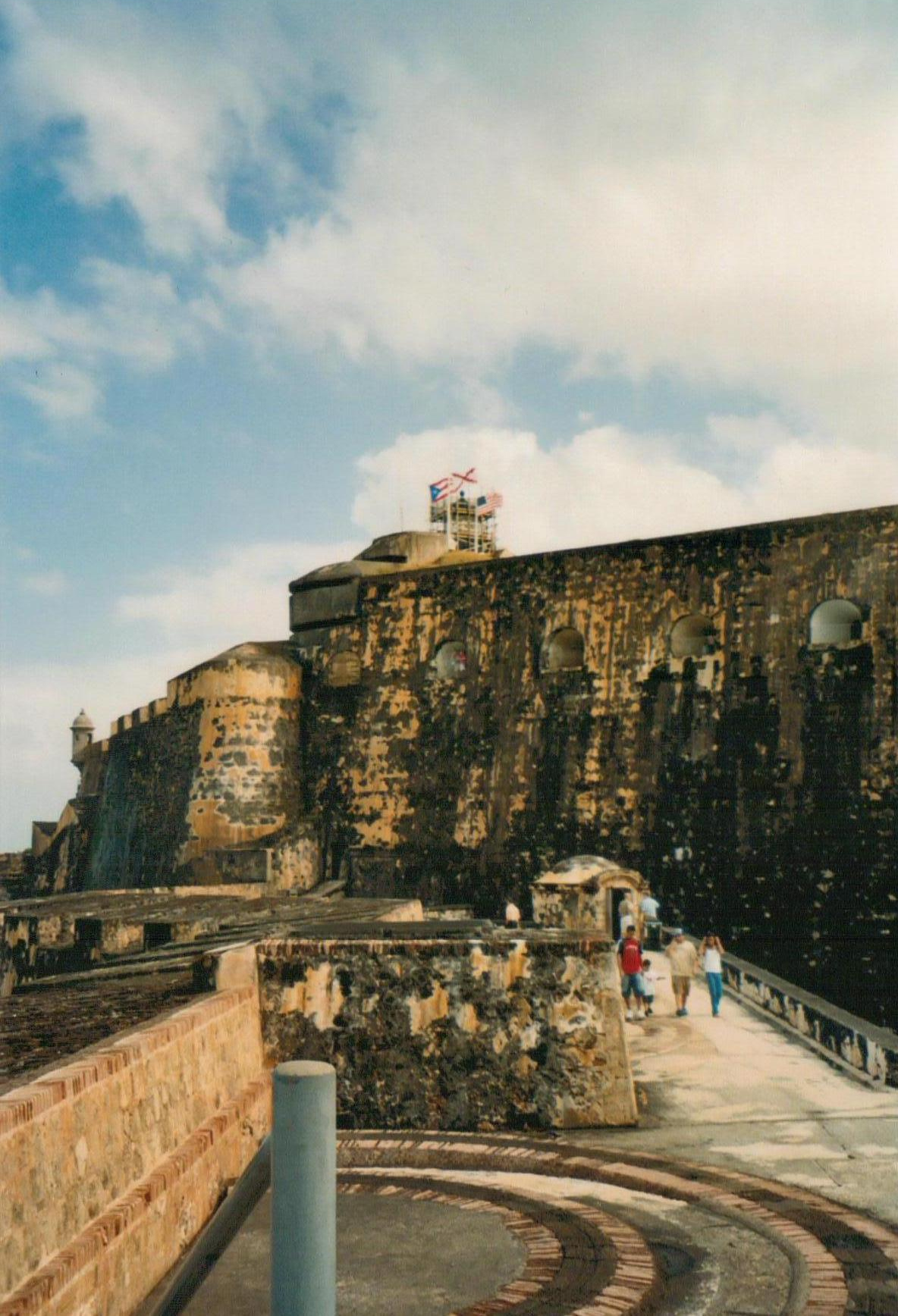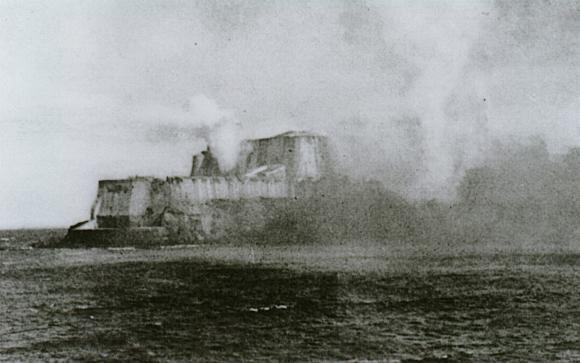|
Fortín San Juan De La Cruz
Fortín San Juan de la Cruz (''Fort John of the Cross, Saint John of the Cross''), known locally as El Cañuelo, was built on Isla de Cabras in the Palo Seco, Toa Baja, Puerto Rico, Palo Seco barrio of the municipality of Toa Baja, Puerto Rico, Toa Baja, at the western end of the entrance to San Juan Bay, in Puerto Rico. The square Coastal defence and fortification, coastal fort has massive sandstone walls that date back to the 1630s. Although the U.S. Navy bombarded the fort in 1898, the fort survived. Today the fort is part of the San Juan National Historic Site, which is listed as a World Heritage Site, UNESCO World Heritage Site and on the National Register of Historic Places. The fort is not open to visitors, but it can be viewed from its exterior. History The original fort built on this site in the late 1500s was made of wood; it burned to the ground in 1625 during a Battle of San Juan (1625), Dutch attack. However, the Spaniards replaced it with a stone fort between 1630 a ... [...More Info...] [...Related Items...] OR: [Wikipedia] [Google] [Baidu] |
Toa Baja, Puerto Rico
Toa Baja (, ) is a town and municipality of Puerto Rico located in the northern coast, north of Toa Alta and Bayamón; east of Dorado; and west of Cataño. Toa Baja is spread over five barrios, including Toa Baja Pueblo (the downtown area and the administrative center of the city). Toa Baja is part of the San Juan-Caguas-Guaynabo Metropolitan Statistical Area. Toa Baja is located fifteen minutes by car from San Juan and two hours from Ponce. History The region of what is now Toa Baja belonged to the Taíno region of Toa and Bayamón, which was located on the north coast of Puerto Rico. The regions were led by cacique Aramana and Majagua respectively. During the Spanish colonization, a farm was settled in the region around 1511 where Spanish settlers tried to learn from the Taínos how to grow fruits and vegetables. Some of the families who settled in the region were Marrero, Salgado, and Martínez, from the Canary Islands. In 1745, the town was officially organized, with ... [...More Info...] [...Related Items...] OR: [Wikipedia] [Google] [Baidu] |
Castillo San Felipe Del Morro
Castillo San Felipe del Morro, also known as El Morro, is a citadel built between 16th and 18th centuries in San Juan, Puerto Rico.www.nps.gov - San Juan National Historic Site - The Gibraltar of the Caribbean - Accessed on 2014-11-29 Development Lying on the northwesternmost point of the islet of , Castillo San Felipe del Morro is named in honor of King . The fortification, ...[...More Info...] [...Related Items...] OR: [Wikipedia] [Google] [Baidu] |
Forts In Puerto Rico
A fortification is a military construction or building designed for the defense of territories in warfare, and is also used to establish rule in a region during peacetime. The term is derived from Latin ''fortis'' ("strong") and ''facere'' ("to make"). From very early history to modern times, defensive walls have often been necessary for cities to survive in an ever-changing world of invasion and conquest. Some settlements in the Indus Valley civilization were the first small cities to be fortified. In ancient Greece, large stone walls had been built in Mycenaean Greece, such as the ancient site of Mycenae (famous for the huge stone blocks of its 'cyclopean' walls). A Greek '' phrourion'' was a fortified collection of buildings used as a military garrison, and is the equivalent of the Roman castellum or English fortress. These constructions mainly served the purpose of a watch tower, to guard certain roads, passes, and borders. Though smaller than a real fortress, they ... [...More Info...] [...Related Items...] OR: [Wikipedia] [Google] [Baidu] |
17th-century Establishments In Puerto Rico
The 17th century lasted from January 1, 1601 ( MDCI), to December 31, 1700 ( MDCC). It falls into the early modern period of Europe and in that continent (whose impact on the world was increasing) was characterized by the Baroque cultural movement, the latter part of the Spanish Golden Age, the Dutch Golden Age, the French ''Grand Siècle'' dominated by Louis XIV, the Scientific Revolution, the world's first public company and megacorporation known as the Dutch East India Company, and according to some historians, the General Crisis. From the mid-17th century, European politics were increasingly dominated by the Kingdom of France of Louis XIV, where royal power was solidified domestically in the civil war of the Fronde. The semi-feudal territorial French nobility was weakened and subjugated to the power of an absolute monarchy through the reinvention of the Palace of Versailles from a hunting lodge to a gilded prison, in which a greatly expanded royal court could be more easily ... [...More Info...] [...Related Items...] OR: [Wikipedia] [Google] [Baidu] |
Sea Forts
The sea, connected as the world ocean or simply the ocean, is the body of salty water that covers approximately 71% of the Earth's surface. The word sea is also used to denote second-order sections of the sea, such as the Mediterranean Sea, as well as certain large, entirely landlocked, saltwater lakes, such as the Caspian Sea. The sea moderates Earth's climate and has important roles in the water, carbon, and nitrogen cycles. Humans harnessing and studying the sea have been recorded since ancient times, and evidenced well into prehistory, while its modern scientific study is called oceanography. The most abundant solid dissolved in seawater is sodium chloride. The water also contains salts of magnesium, calcium, potassium, and mercury, amongst many other elements, some in minute concentrations. Salinity varies widely, being lower near the surface and the mouths of large rivers and higher in the depths of the ocean; however, the relative proportions of dissolved salts vary ... [...More Info...] [...Related Items...] OR: [Wikipedia] [Google] [Baidu] |
Spanish Language
Spanish ( or , Castilian) is a Romance languages, Romance language of the Indo-European language family that evolved from colloquial Latin spoken on the Iberian peninsula. Today, it is a world language, global language with more than 500 million native speakers, mainly in the Americas and Spain. Spanish is the official language of List of countries where Spanish is an official language, 20 countries. It is the world's list of languages by number of native speakers, second-most spoken native language after Mandarin Chinese; the world's list of languages by total number of speakers, fourth-most spoken language overall after English language, English, Mandarin Chinese, and Hindustani language, Hindustani (Hindi-Urdu); and the world's most widely spoken Romance languages, Romance language. The largest population of native speakers is in Mexico. Spanish is part of the Iberian Romance languages, Ibero-Romance group of languages, which evolved from several dialects of Vulgar Latin in I ... [...More Info...] [...Related Items...] OR: [Wikipedia] [Google] [Baidu] |
Albert Nofi
Albert A. Nofi (born January 6, 1944), is an American military historian, defense analyst, and designer of board and computer wargaming systems. Early life A native of Brooklyn, he attended New York City public schools, graduating from the Boys' High School (now Boys and Girls High School) in 1961. Nofi attended Fordham University, earning a bachelor's (1965) and a master's (1967), and then received a Ph.D. in Military History from the City University of New York (1991). Career From 1965 through 1995, Nofi was a teacher and later administrator in the New York City public schools. Working primarily in alternative programs, such as the Harlem Preparatory School, Park East High School, and Unity High School at the Door, he retired as an assistant principal in 1995. During this period he also built a parallel career as an independent historian, defense analyst, and wargame designer, working primarily with James F. Dunnigan, Redmond A. Simonsen, and David C. Isby at Simulations Pub ... [...More Info...] [...Related Items...] OR: [Wikipedia] [Google] [Baidu] |
Bombardment Of San Juan
The Bombardment of San Juan, or the First Battle of San Juan, on 12 May 1898 was an engagement between United States Navy warships and the Spanish fortifications of San Juan, Puerto Rico. It was the first major action of the Puerto Rican Campaign during the Spanish–American War. Background Under the command of Rear Admiral William T. Sampson, a U.S. fleet—consisting of the flagship armored cruiser , battleships and , the unprotected cruisers and , the monitors and , the torpedo boat , the auxiliary cruiser , the collier , and two unarmed yachts transporting officials and the press,—prepared to attack Puerto Rico. Their mission was to intercept the Spanish Admiral Pascual Cervera y Topete and his fleet steaming from the Cape Verde Islands to the Antilles. American commanders believed the Spanish fleet was steaming for Puerto Rico. With this understanding, Sampson set steam from Key West and lifted anchor at about noon on 2 May, for the Spanish province. The Flee ... [...More Info...] [...Related Items...] OR: [Wikipedia] [Google] [Baidu] |
Causeway
A causeway is a track, road or railway on the upper point of an embankment across "a low, or wet place, or piece of water". It can be constructed of earth, masonry, wood, or concrete. One of the earliest known wooden causeways is the Sweet Track in the Somerset Levels, England, which dates from the Neolithic age. Timber causeways may also be described as both boardwalks and bridges. Etymology When first used, the word ''causeway'' appeared in a form such as "causey way" making clear its derivation from the earlier form "causey". This word seems to have come from the same source by two different routes. It derives ultimately, from the Latin for heel, ''calx'', and most likely comes from the trampling technique to consolidate earthworks. Originally, the construction of a causeway utilised earth that had been trodden upon to compact and harden it as much as possible, one layer at a time, often by enslaved bodies or flocks of sheep. Today, this work is done by machines. The s ... [...More Info...] [...Related Items...] OR: [Wikipedia] [Google] [Baidu] |
Bartizan
A bartizan (an alteration of ''bratticing''), also called a guerite, ''garita'', or ''échauguette'', or spelled bartisan, is an overhanging, wall-mounted turret projecting from the walls of late medieval and early-modern fortifications from the early 14th century up to the 18th century. Most frequently found at corners, they protected a warder and enabled him to see his surroundings. Bartizans generally are furnished with oillets or arrow slits. The turret was usually supported by stepped masonry corbels and could be round, polygonal or square. Bartizans were incorporated into many notable examples of Scottish Baronial architecture. In the architecture of Aberdeen, the new Town House, built in 1868–74, incorporates bartizans in the West Tower. Gallery At walls File:Round Bartizan, Fortaleza de Santiago, Sesimbra, Portugal.JPG, ''Guarita'' at Fortaleza de Santiago, Sesimbra Municipality, Portugal. File:Sudika Isla watchtower.jpg, ''Gardjola'' at the Spur, Senglea, Malt ... [...More Info...] [...Related Items...] OR: [Wikipedia] [Google] [Baidu] |
Fort
A fortification is a military construction or building designed for the defense of territories in warfare, and is also used to establish rule in a region during peacetime. The term is derived from Latin ''fortis'' ("strong") and ''facere'' ("to make"). From very early history to modern times, defensive walls have often been necessary for cities to survive in an ever-changing world of invasion and conquest. Some settlements in the Indus Valley civilization were the first small cities to be fortified. In ancient Greece, large stone walls had been built in Mycenaean Greece, such as the ancient site of Mycenae (famous for the huge stone blocks of its 'cyclopean' walls). A Greek ''Towns of ancient Greece#Military settlements, phrourion'' was a fortified collection of buildings used as a military garrison, and is the equivalent of the ancient Roman, Roman castellum or English language, English fortress. These constructions mainly served the purpose of a watch tower, to guard certa ... [...More Info...] [...Related Items...] OR: [Wikipedia] [Google] [Baidu] |







.jpg)
